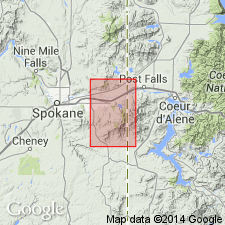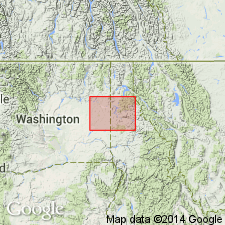
- Usage in publication:
-
- Newman Lake Gneiss*
- Modifications:
-
- Named
- Dominant lithology:
-
- Gneiss
- Schist
- AAPG geologic province:
-
- Northern Rocky Mountain region
Summary:
Named for exposures on the north and west sides of Newman Lake, Mt. Spokane quad, Spokane Co, WA, in the Northern Rocky Mountain region. Extends south occurring in the north part of the present quad. Gradationally overlies over an interval of 100 to 200 ft the newly named Houser Lake Gneiss. Bounded on north by Cretaceous? alaskite. Consists of medium-grained, dark-gray gneiss with abundant porphyroblasts (1/2 to 2 in) of white potassium feldspar. Locally contains remnants of fine-grained, dark, crumpled, contorted banded schist. Precambrian age.
Source: GNU records (USGS DDS-6; Denver GNULEX).

- Usage in publication:
-
- Newman Lake Gneiss
- Modifications:
-
- Not used
Summary:
Not used in map area [which includes the type locality]. Rocks mapped by Weis (1968) as Newman Lake Gneiss are mapped in this report as the porphyroblastic gneiss, an unnamed unit of the Prichard. [No explanation given for non-use of name Newman Lake nor of its status as a formal unit.]
Source: GNU records (USGS DDS-6; Denver GNULEX).
For more information, please contact Nancy Stamm, Geologic Names Committee Secretary.
Asterisk (*) indicates published by U.S. Geological Survey authors.
"No current usage" (†) implies that a name has been abandoned or has fallen into disuse. Former usage and, if known, replacement name given in parentheses ( ).
Slash (/) indicates name conflicts with nomenclatural guidelines (CSN, 1933; ACSN, 1961, 1970; NACSN, 1983, 2005, 2021). May be explained within brackets ([ ]).

